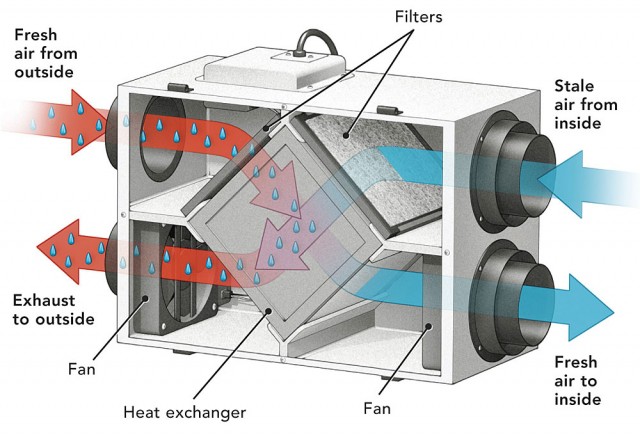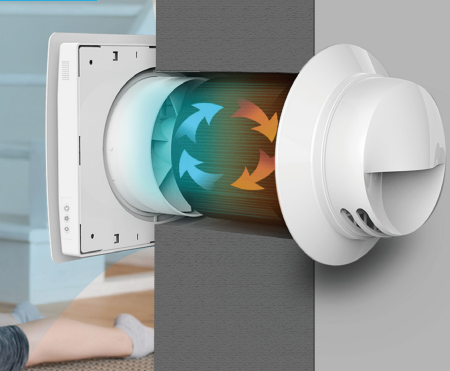The All-Inclusive Overview to the Uses of Heat Recovery Ventilation in Modern Buildings
Heat Recovery Ventilation (HRV) systems represent a considerable improvement in building innovation (HRV Heat Recovery Ventilation). They provide a technique for exchanging stagnant indoor air with fresh outside air while minimizing energy loss. This strategy not only boosts indoor air top quality yet also adds to energy effectiveness in both household and industrial structures. Understanding the different applications and advantages of HRV can reveal its essential duty in modern style and sustainability initiatives. The implications of this innovation deserve exploring even more
Understanding Heat Recovery Ventilation Equipments

Although many contemporary structures focus on power efficiency, understanding warm healing air flow (HRV) systems is essential for optimizing interior air top quality and reducing energy usage. HRV systems function by moving warmth from stale indoor air to incoming fresh air, effectively preserving comfy interior temperature levels while reducing energy loss. These systems are composed of a warm exchanger, followers, and ductwork that help with the circulation of air. During winter, HRV units capture and reuse warm from the outbound air, while in summertime, they can aid cool inbound air. By continually trading air, HRV systems additionally lower moisture and the focus of indoor pollutants. Correct installment and upkeep of HRV systems are necessary for their performance and efficiency in enhancing overall building efficiency and convenience.
Advantages of Heat Recovery Ventilation
Heat recovery ventilation systems offer countless advantages that enhance both power efficiency and interior air high quality in modern structures. By catching and reusing power from exhaust air, these systems considerably decrease cooling and heating expenses, leading to lower power usage. They preserve a steady flow of fresh outdoor air, lessening the risk of interior air toxins and allergens. This constant exchange helps manage humidity degrees, stopping mold growth and ensuring a healthier living environment. Additionally, HRV systems add to sustainability goals by decreasing general carbon footprints. Their capability to optimize air flow without sacrificing thermal convenience makes them an important enhancement to modern building style, advertising both financial and ecological benefits.
Applications of HRV in Residential Structures
As house owners progressively prioritize energy performance and indoor air high quality, the applications of warmth recovery ventilation (HRV) systems in household structures have ended up being much more widespread. HRV systems are particularly helpful in tightly sealed homes, where preserving fresh air flow is crucial for avoiding dampness build-up and interior pollutants. They efficiently move warm from outgoing stagnant air to incoming fresh air, reducing energy expenses connected with heating and cooling. Additionally, HRVs can enhance comfort degrees by regulating moisture and temperature level. They are also versatile for different property layouts, consisting of single-family homes and multi-unit structures. On the whole, incorporating HRV continue reading this systems sustains lasting living techniques while guaranteeing a healthier indoor setting for occupants.
HRV in Business and Commercial Settings
In commercial and industrial settings, the application of heat healing air flow (HRV) systems has become increasingly critical for enhancing power efficiency and maintaining air quality. These systems effectively transfer heat from exhaust air to incoming fresh air, decreasing the requirement for added heating or air conditioning. This not just lowers power prices yet likewise contributes to sustainability initiatives. Industries such as production, warehousing, and office complex benefit significantly from HRV systems, as they help regulate temperature and humidity levels, making sure a comfortable and productive environment. HRV systems aid in getting rid of pollutants and excess wetness, improving indoor air high quality. As regulations around air quality end up being stricter, the fostering of HRV innovation is likely to expand, making it a crucial part of modern industrial and commercial framework.
Future Fads in Heat Recovery Ventilation Innovation

Frequently Asked Concerns
Just How Does Heat Recovery Ventilation Influence Indoor Air High Quality?
Heat recovery ventilation considerably boosts interior air top quality by constantly trading stagnant indoor air with fresh outside air while recouping energy. This procedure minimizes contaminants, keeps perfect moisture levels, and ensures a much healthier atmosphere for owners.
Can HRV Solutions Be Installed in Existing Structures?
HRV systems can without a doubt be mounted in existing buildings. Retrofitting might call for alterations to ductwork and ventilation formats, but it considerably enhances energy performance and interior air top quality, making it a practical alternative for older frameworks.
What Upkeep Is Needed for HRV Solutions?

Are There Specific Climates Where HRV Is Extra Efficient?
Heat recovery ventilation systems are particularly reliable in environments with considerable temperature differences between seasons. These systems optimize energy efficiency by recuperating heat from exhaust air, making them ideal for both cold and reasonably warm atmospheres.
How Do HRV Solutions Affect Power Bills?
